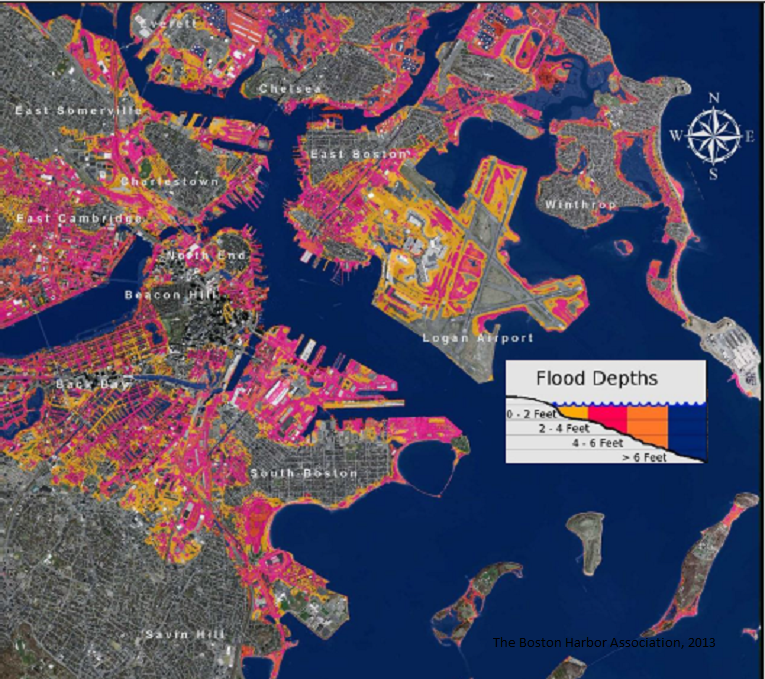 Source: The Boston Harbor Associatioin
Source: The Boston Harbor AssociatioinMetropolitan Boston’s population is 4.5 million and within the city limits, 636,000 citizens reside. The expected city budget for 2014 is $2.6 billion. The mayor has set aside $18 million to support adaptation initiatives. The local economy relies heavily on the Port of Boston and Logan airport. Together they contribute approximately $9.6 billion (Mass Port 2013) annually to the local economy.
Recently the city completed a highway project called “The Big Dig” which took over 30 years to complete and exceeded the estimated cost of $2.8 billion, ultimately totaling $22 billion (Murphy, 2008). This project, with its series of bridges and tunnels has increased the vulnerability of Boston’s transportation infrastructure to storm surge and sea level rise. With 3 million commuters traveling in the city each day on this infrastructure, the economy and people are made susceptible to climate change risks.
Beginning the climate risk analysis (Mehrotra et al., 2009) for Boston, the main climate hazards are sea level rise and increases in temperature and precipitation amounts. Sea level is anticipated to increase 2.5 feet by 2050 and 6 feet by 2100 (Mehta 2011). The anticipated increase of the temperature is 2 to 2.3 degrees Fahrenheit by 2030 and 5.2 to 8.8 degrees Fahrenheit by 2100 (Mahta, 2011), causing the heat island effect to exacerbate this issue. It is estimated the number of days above 90 degrees Fahrenheit will increase to 30 each year (Mehta 2011). Moreover, as Nor’Easters and storms are anticipated to occur more frequently the increase in precipitation will contribute to the severity of flooding and storm surge.
Situated in the North Atlantic with a propensity to experience Nor’Easters, hurricanes, and coastal storm surge, Boston is vulnerable to increasing sea levels. Two thirds of the cities (1800 acres) consist of landfill (City-data, 2013). Salt water intrusion from damaging floods will weaken infrastructure. The economy will be affected due to the damage caused to transportation infrastructure. The operation of the Boston subway system, the oldest in the country, will be compromised by any water intrusion.
Adaptive capacity addressing overall carbon reduction in Boston is comprehensive. In 2007 the Mayor issued an executive order for Climate Action. He has established a Community Action Task Force through the office of Energy and Environmental Affairs. A carbon mitigation plan was created in 2013 with a city wide carbon reduction goal of 25% by 2020 and 80% by 2050 (City of Boston, 2013). Boston has high adaptive capacity with financial and political capability.
Boston must consider re-establishing the natural coastal protection it once had in collaboration with Boston Redevelopment Authority. Restoring coastal wetlands around the city, East Boston and Logan airport will help mitigate damage from storm surge. Boston should work with the water and sewer commission to install pumps in all tunnels and enclosed backup generators in the event of power outages. Planting trees along roads and constructing bioswales will help to capture runoff from heavy precipitation events. Steps must be taken by local government and all involved city departments to ensure that these efforts are undertaken as part of a coordinated climate adaptation plan to ensure efficiency and effectiveness. Working with state and federal government and the city council, the mayor’s office must work to generate and allocate the funds necessary for these projects.
This article is a product of Professor Shagun Mehrotra’s Climate Change and Cities class. Views expressed are entirely those of the individual author.
References
City-data.com. (2013). Boston, MA profile. Retrieved 10/1, 2013, from City-data.com
City of Boston. (2013). Preparing for climate change. Retrieved 10/1, 2013, from http://www.cityofboston.gov/climate/adaptation/
Boston Greenovate. (2013). Climate ready Boston. Retrieved 11/15, 2013, from http://www.cityofboston.gov/news/uploads/30044_50_29_58.pdf
James Neumann, J. P. (2009). Adapting climate change, the public response, public infrastructure. Resources for the Future
Lemonick, M. (2013). East coast faces rising seas from slowing gulf stream. Retrieved 12/1, 2013, from http://www.climatecentral.org/news/east-coast-faces-rising-seas-from-slowing-gulf-stream-15587
Martin Vermeera, S. R. (2009). Global sea level linked to global temperature. Proceeding of National Academy of Sciences of the United States of America, 106(51), 21527-21532.
McLaughlin, T., & Honan, E. (2013). Blizzard hammers U.S. northeast, five dead, 700,000 lose power. Retrieved 12/1, 2013, from http://www.reuters.com/article/2013/02/09/us-usa-weather-idUSBRE91611P2030209
Mehrotra, S., C.E. Natenzon, A. Omojola, R. Folorunsho, J. Gilbride & C. Rosenzweig. (2009). Framework for city climate risk assessment. Washington, DC: World Bank.
Mehta. M (2011). Boston, Massachusetts: Identifying and becoming more resilient to impacts of climate change . Retrieved 10/1, 2013, from http://www.nrdc.org/water/files/ClimateWaterFS_BostonMA.pdf
n.a. (2013). Boston. Retrieved 10/1, 2013, from http://www.socialexplorer.com
Murphy, S. (2008). Big dig’s red ink engulfs state . Retrieved 11/30, 2013, from http://www.boston.com/news/traffic/bigdig/articles/2008/07/17/big_digs_red_ink_engulfs_state/
The Boston Harbor Association. Climate change adaptation. Retrieved from http://www.tbha.org/climate-change-adaptation
Public Works Staff. (2007). Portland’s porous pavement a prize. Retrieved 10/22, 2013, from http://www.pwmag.com/bleeding/portland-s-porous-pavement-a-prize.aspx
Schworm, P., & Finucane, M. (2012). Hurricane sandy slams east coast. Retrieved 11/28, 2013, from http://www.boston.com/news/local/massachusetts/2012/10/29/hurricane-sandy-slams-east-coast/4LsKmqiG7UPcYN5a9m2PgJ/story.html
U.S. Census Bureau. (2013). Boston (city), massachusetts. Retrieved 10/1, 2013, from http://quickfacts.census.gov/qfd/states/25/2507000.html